Do I need a special Air EQ?
- Intro
- Results Hishelf
- Fazit Hishelf
- Results Bell
- Fazit Bell-EQs
We want to find answers to the questions...
- Do I need such a special Air-EQ?
- What do I need to pay attention to with EQs and high frequencies?
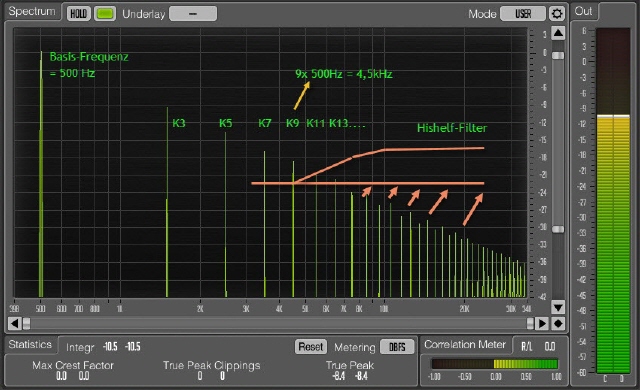
I took a few EQs from my pool and sent a square wave signal through them, which contains every odd overtone to the fundamental frequency (here 500Hz). First, all EQs were set to amplify everything with +4dBs using a Hi-Shelf filter above 5kHz. The measurements behind the EQ were done with the VST oscilloscope (link below).
If you want to do the same with your EQs, use this signal: rectangle.wav [1’292 KB]
You can use this oscilloscope:
https://www.kvraudio.com/product/oscilloscope-by-socalabs
How do I read the obtained curves?
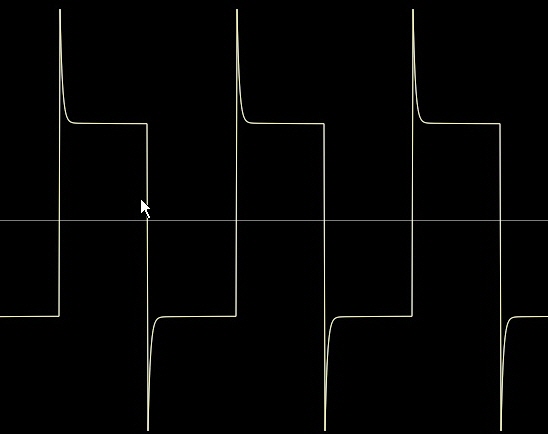
Ideally, the signal should look like the one on the right.
Why?
During the rapid rise of the flank into the horizontal and the abrupt change back into the lower horizontal, the fast frequencies are mainly present. These are amplified in the experimental setup. Despite a rapid drop, the filter "does not overshoot". Note in the "Results Hi-Shelf" tab what the different equalizers produce...
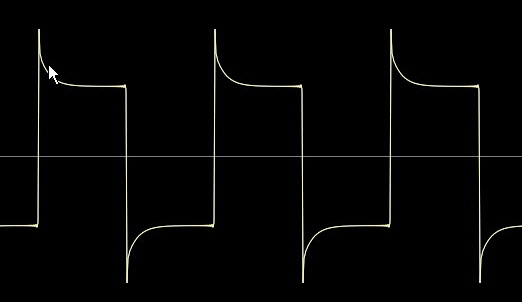
If the curve shows such a behavior, the filter attenuates the signal a bit more than necessary. These filters do not sound shrill when the highest frequencies are boosted. You could say that such EQs amplify the airband "musically". A typical representative of this class is the EQ Millennia NSEQ-2 and the freeware EQ Slicker EQ "German" (only shown in the tutorial Mixing an Orchestra).
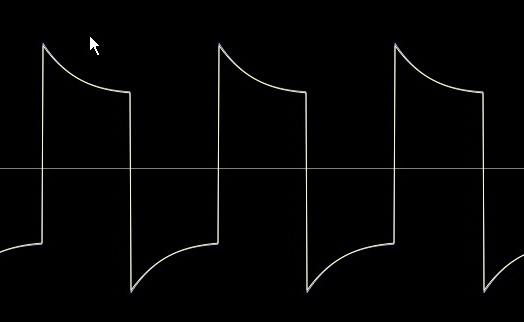
If an EQ shows such a curve, it is usually not fast enough for real "air tasks". This EQ can be used for everything else. It probably sounds rather warm and certainly not shrill. But for "air tasks" it is - as already mentioned - not suitable. At the same time, the somewhat "inclined plane" indicates that the filter also attenuates the very low frequencies on its own. Typical representatives here: The SSL4000 input channel and the PSP NobleQ. So these two EQs are better used if a warm sound is asked.
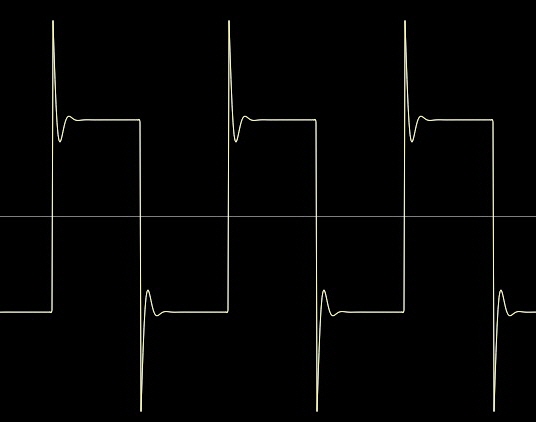
This curve shows us that the filter tends to " oscillate" at high frequencies. You can called it the "ringing effect". These filters usually tend to sound more "shrill" than neutral when amplifying the highest frequencies. So they overdo the Effect. If Bell filters are used, almost all EQs also show this behavior. With the tested EQs with the selection "Hi-Shelf" I also could notice this behavior a bit with the VSL Master EQ (Suite1), with the freeware TDR Nova and with the freeware TDR SlickEQ "Soviet" (only shown in the Tutorial "Mixing an Orchestra").
I recommend testing your own EQ here to see if it is suitable for Air tasks.
Attention: EQs with such behavior are not bad, they are just not particularly suitable for air EQ tasks with the settings shown.
There are many EQs that solve the task very well and above all neutrally. They are all good at raising the AIR frequencies.
The Fabfilter EQ (H) also does a good Air-EQ job if you don't use it in "Natural Phase" mode and only set a slope steepness of 6dB/Oct or 12dB/Oct.
The EQ Millennia NSEQ-2 seems to be so well damped that it certainly does not ring by itself in any case. So the treble sounds therefore never sharp despite the boost - in other words, it sounds very musical.
Personally, I like the Millenia NSEQ-2 very much to raise the treble of voices (soprano). For general purposes, I often use the Baxter in M/S-Mode.
Special:
Interesting that the MÄAG EQ4 does not come close to the quality of MÄAG EQ2 (compare Picture A) & B).
The freeware Luftikus already distorts with no Gain (C1). The curve compared to Mäag 4 & 2 is not so clean with Luftikus (compare A) & B) with C2)
Likewise, the freeware EQ TDR NOVA does not manage to remain neutral at high frequencies. It tends to overshoot.
Only when Q is set to 0.5 will the overshoot be reduced. But then the curve is still not perfect. If you switch to ECO, the small overshoot also disappears. Maybe this is musically interesting. Neutral it is not. (K1-3)
Basically, tube-emulating EQs or those that emulate special (vintage) EQs seem to have problems reproducing the highest frequencies neutrally. This is shown by the NobleQ from PSP and the SSL4000 emulation of PlugInAlliance. However, these two EQs are meant to add warmth, not airy highs.
So some HiShelf filters have a perfect output signal even at Q = 1 (Cubase StudioEQ).
With others you have to set a Q of 0.3 or 0.4 so that the filters do not overshoot (VSL MAstering EQ, TDR Nova).
SUMMARIZED:
We get a neutral EQ for the airband with most EQs with the following conditions:
HiShelf, Q=0.2 - 0.5, 12dB/octave, ECO mode, Normal mode, no phase correctors or other special effects....
No "warming-EQs" no "Vintage EQs" no other similar special EQs...
Test your EQ-Output before using it as Airband - EQ
In summary, all Hishelf EQs are suitable for boosting the airy highs. Even the usual Cubase StudioEQ does the job well.
However, one can also state that the more expensive special EQs, such as Millenia, Baxter or Mäag solve their thing a bit better. Whether you want to spend the money for it, everyone must know for themselves.
Recommended:
Test your favorite Air EQ in the same way as I've done it.
© Copyright, Createc Beat Kaufmann, 2004 - 2025












































